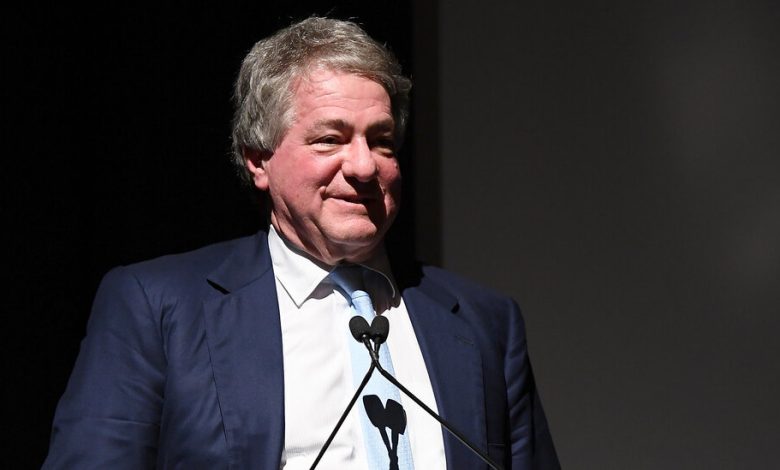A Giacometti for a Cezanne: Jeffrey Epstein’s Role in a Pricey Art Deal

In late 2016, when the private equity mogul Leon Black was trying to sell one expensive piece of art to buy another without incurring a hefty tax bill, he turned to the one man he knew who could help pull it off: his friend Jeffrey Epstein.
On Nov. 23 that year, Mr. Black sold an Alberto Giacometti sculpture from his massive private art collection for $25 million to a trust controlled by Mr. Epstein, by then a registered sex offender, according to documents viewed by The New York Times. That same day, a company linked to Mr. Black used the proceeds from that sale to buy a watercolor painting by Paul Cezanne for $30 million.
Mr. Black, a co-founder of Apollo Global Management, took advantage of an incentive that allows an investor to defer paying capital gains taxes on the sale of an asset if the proceeds are quickly rolled over into the purchase of a “like kind” asset of equal or greater value. Although the incentive was intended mainly to encourage new construction by real estate developers, private art collectors often used it until the 2017 tax law closed the loophole.
The documents, the contents of which have not been previously reported, offer a rare look at some of the high-priced tax and estate advisory work that Mr. Epstein provided Mr. Black in the years before he was arrested on federal sex-trafficking charges in July 2019. Mr. Black, who had known Mr. Epstein for years, paid $158 million to Mr. Epstein for services such as the art transaction from 2013 to 2017.
The Senate Finance Committee is investigating the tax work that Mr. Epstein did for Mr. Black, putting renewed scrutiny on the business and social ties between the two men. In July, Senator Ron Wyden of Oregon, the committee’s Democratic chair, sent a letter to Mr. Black asking for an explanation of why he had paid $158 million in fees when lawyers generally charge far less for similar tax and estate services.
The Senate committee has been focusing on tax avoidance schemes used by the superwealthy. With regards to Mr. Black, the committee is looking into whether “the exorbitant amounts paid to Epstein should have been classified as a gift for federal tax purposes” and a possible justification for Mr. Black to seek out Mr. Epstein for tax and estate work.
The letter also asked for detailed information about Mr. Epstein’s work for Mr. Black and a list of any art sales over $1 million that the disgraced financier had advised the billionaire on.
The committee is looking into several dozen entities connected to the two men, including the Haze Trust, a person briefed on the investigation said. The Haze Trust, which Mr. Epstein controlled, is the entity that bought the Giacometti, according to the documents.
The transactions between Mr. Epstein and Mr. Black most likely met the technical requirements of the federal tax code, said Victoria Haneman, a professor at Creighton University School of Law who specializes in tax and estate law. But they “certainly raise an eyebrow about whether tax avoidance was the main driver,” Ms. Haneman said, and “could be questioned as ‘straw man’ transactions.”
Mr. Black, whose net worth is estimated at $9 billion, was one of Mr. Epstein’s biggest clients after Mr. Epstein pleaded guilty in 2008 to a Florida charge of soliciting prostitution from a teenage girl. The Wall Street billionaire was also a frequent visitor to Mr. Epstein’s Manhattan mansion — often going for breakfast and other social events.
After Mr. Epstein killed himself in a federal jail in August 2019, news reports and other disclosures about Mr. Black’s dealings with Mr. Epstein led to his resignation from Apollo in early 2021. The controversy also led him to not seek another term as chairman of the Museum of Modern Art in New York.
In January, Mr. Black reached a $62.5 million settlement with the U.S. Virgin Islands to avoid a lawsuit over his ties to Mr. Epstein, who had lived and worked in the U.S. territory for nearly two decades before his arrest.
Despite the controversies, Mr. Black, 72, remains an important figure in the art world, with a private collection worth $1 billion. In 2012, he made news for his $120 million purchase of a version of Edvard Munch’s “The Scream.” His vast collection includes works by Leonardo da Vinci, Edgar Degas, Francisco Goya, Henri Matisse, Joan Miro, Pablo Picasso, Rembrandt, Richard Serra and Andy Warhol, according to regulatory filings.
The documents reviewed by The Times do not offer an explanation for why Mr. Black wanted to sell the bronze Giacometti statue, “Figure Moyenne II,” and buy Cezanne’s “Portrait de Vallier de Profil.”
Whit Clay, a spokesman for Mr. Black, said the transactions in 2016 “were completely legal and appropriate,” and “Mr. Black paid Epstein for legitimate financial advisory services.”
A representative for the Epstein estate declined to comment.
The discussions appear to have begun in early November 2016, according to the documents viewed by The Times. In discussing the deal with one of his assistants, Mr. Epstein said in an email, “We might do it after I speak to Leon.”
To help pay for the Giacometti, Mr. Epstein had his staff wire $23 million into a Haze Trust account the day before the transaction took place, the documents show. The money was wired from an account belonging to Southern Trust, which was Mr. Epstein’s main moneymaking company in the Virgin Islands and received a lucrative tax break from the U.S. territory. Most of Southern Trust’s revenue came from the fees Mr. Black paid.
From a tax law perspective, Professor Haneman said, the sale of the Giacometti to Mr. Epstein most likely qualified as an arm’s length transaction. But given the relationship between Mr. Epstein and Mr. Black, it may not be “arm’s length in any practical sense.”
The transaction involving the Haze Trust was set up to take advantage of a provision in the federal tax code called a 1031 exchange and went through a third party that essentially served as a middleman in the deal.
So-called 1031 exchanges are normally used by real estate investors — especially in commercial real estate — when they sell one property and simultaneously buy another. Supporters of the provision say it encourages real estate activity, but detractors argue that it’s merely a tax dodge for the wealthy. In theory, capital gains can be deferred for decades, if an investor keeps rolling proceeds from a property sale into a similar asset.
Chicago Deferred Exchange Company, a financial firm that specializes in 1031 exchanges, created the middleman for the transactions involving the companies linked to Mr. Epstein and Mr. Black, according to the documents.
Chicago Deferred also was the middleman in a 1031 transaction in which the Haze Trust bought Georges Braque’s “Le Guéridon” oil painting from one of Mr. Black’s art companies for $5 million. In that deal, Mr. Black bought another Cezanne painting.
“Mr. Epstein was not our client in this or any other transaction that we facilitated,” Chicago Deferred said in a statement. The company added that it did not get involved in any negotiations between the buyers and sellers.
Its clients were entities that Mr. Black used to buy art.
It’s not clear what happened to the Giacometti sculpture and the Braque painting after Mr. Epstein’s trust bought them. But in 2017, auction houses sold versions of both works to unidentified buyers.
Also in 2017, New York State tax officials opened an audit to determine if Chicago Deferred collected sufficient sales tax from two of Mr. Black’s art holding companies. As of last year, the matter was still pending.
Once the sales tax audit began, Mr. Epstein, in an email to an employee of Mr. Black’s family office, took issue with the transaction. He said, “If you recall, I was quite clear about not liking the idea.”
Steve Eder contributed reporting. Kirsten Noyes contributed research.




